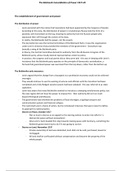Lecture notes
AQA AS/A-Level Revolution and Dictatorship Unit 2N, Chapter 2: The Bolshevik Consolidation of Power 1917-24
- Institution
- AQA
Comprehensive revision notes for the AQA AS/A-Level History Unit 2N Revolution and Dictatorship 1917-53 course, although they can be used for other syllabus'. This document covers the 1917-24 period, which is chapter 2 in the 'Bolshevik and Stalinist Russia 1917-64' textbook by Michael Lynch. Inclu...
[Show more]




